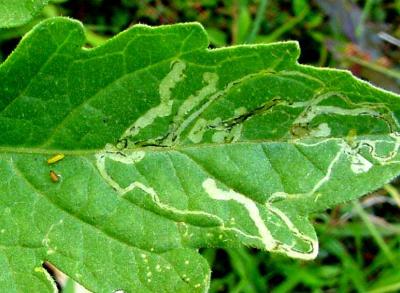

Ana's notes: It is important to differentiate leafmining flies and leafmining caterpillars, since the management of the two groups of pests is different. The leafminers attacking coffee, cotton, groundnut, soybean and citrus are caterpillars, not leafmining flies. Some work was done on neem for control of leafminers on tomatoes some years back, but it was not published. I am looking for it; it should be added when available.
Leafminers (Liriomyza spp.)
Leafmining flies make tiny punctures on the side of tomato leaves when feeding and laying eggs. These punctures may serve as entry point for disease causing organisms such as bacteria and fungi.
The most destructive stages are the immature stages (maggots). Maggots measure up to 3 mm in length. The maggots feed on leaf tissue inside the leaf leaving a wandering track in the form of irregular mines. Heavy mining of leaves may reduce photosynthesis affecting development of flowers and fruits. Heavy attack may cause leaf drop. This is particularly serious for tomato seedlings which may die due to defoliation. Defoliation of tomato plants may also expose fruits to sunburn and affect the market value. Leafminers attack a wide range of cultivated vegetables.
- Conserve natural enemies. Parasitic wasps normally control leafminers. However, the widespread indiscriminate use of persistent broad-spectrum insecticides, to control this and other pests, disrupt the natural control, leading to leafminer outbreaks.
- Rotate with non-host crops and plan the arrangement of fields so that old infested fields do not provide a reservoir of infestation for subsequent crops.
- Destroy leafminer pupae in the soil. This can be done by ploughing and tilling, by solarisation, and, on heavy soils, by flood irrigation.
- Monitor the crop by checking foliage for the presence of stipples caused by the adults while feeding and laying eggs, and for mines and larvae. Trap adult flies with yellow sticky or water traps. For more information on Traps click here.
- If necessary spray with neem-based pesticides. For more information on Neem-based pesticides click here.
